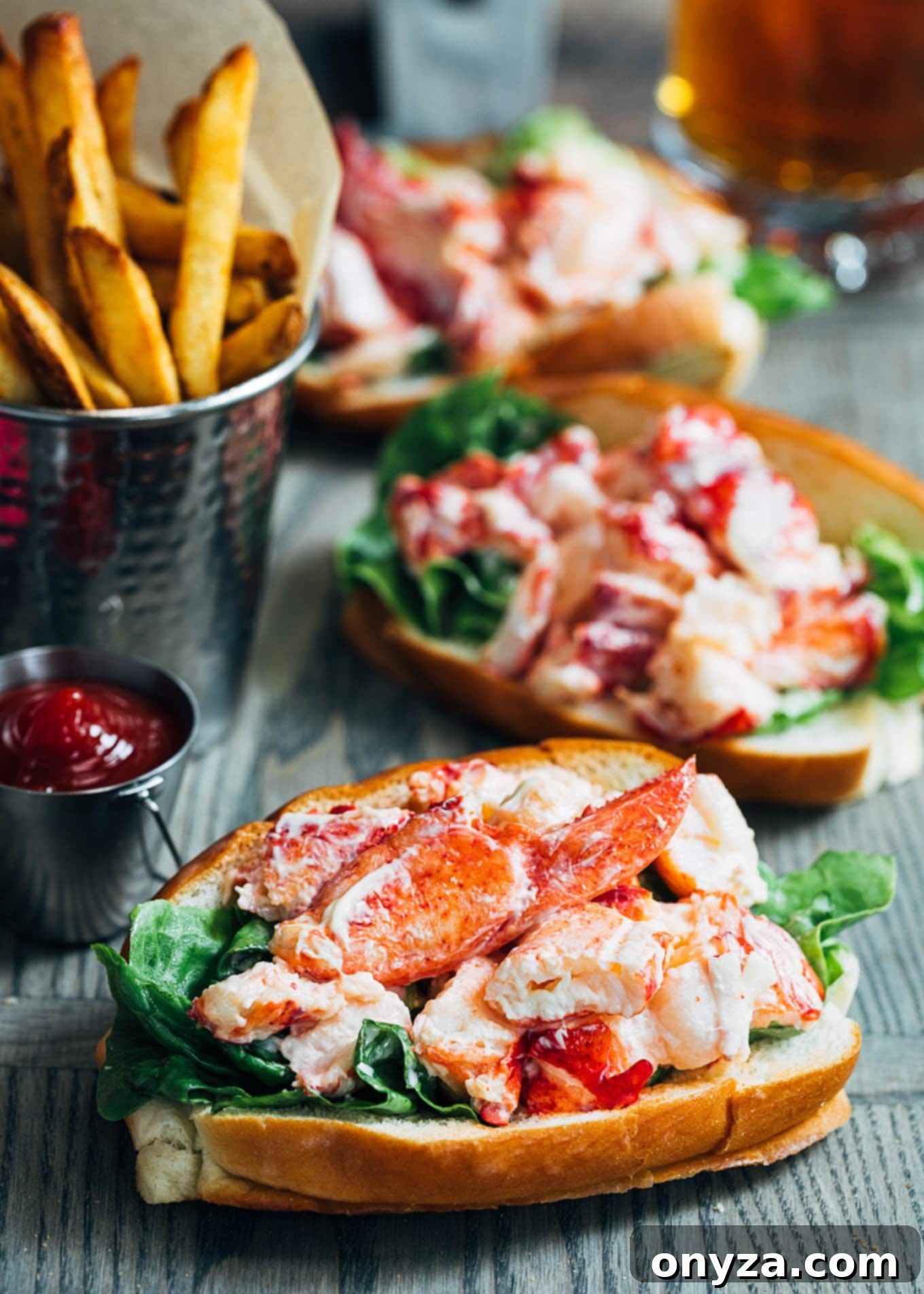Experience the unparalleled taste of coastal New England with these authentic Maine Lobster Rolls. Discover how fresh, simple ingredients combine to create a truly irresistible, quintessential summertime classic.
The Ultimate Guide to Crafting Authentic Maine Lobster Rolls at Home
There’s nothing quite like the experience of a fresh lobster roll, a culinary emblem of the New England coast. My last journey to Maine was a delightful mission to savor every possible lobster dish, and I’m thrilled to report: mission accomplished! The moment I shared a photo of the delectable lobster rolls we enjoyed, my inbox was flooded with requests for the recipe. Naturally, I dove back into preparing some exquisite lobsters to capture every step and, of course, enjoy a few more rolls along the way. Someone has to do it, right?
This comprehensive guide will walk you through the precise elements that define a classic Maine Lobster Roll. We’ll cover everything you need—and just as importantly, what you should omit—to recreate an authentic New England seafood experience right in your own kitchen. Despite the rich detail in this article (my passion for lobster runs deep!), you’ll find that authentic Maine Lobster Rolls are incredibly simple to prepare. With just a handful of fresh ingredients and straightforward techniques, you can transport the vibrant flavors of Maine’s picturesque coastline directly to your dining table, no matter where you call home.
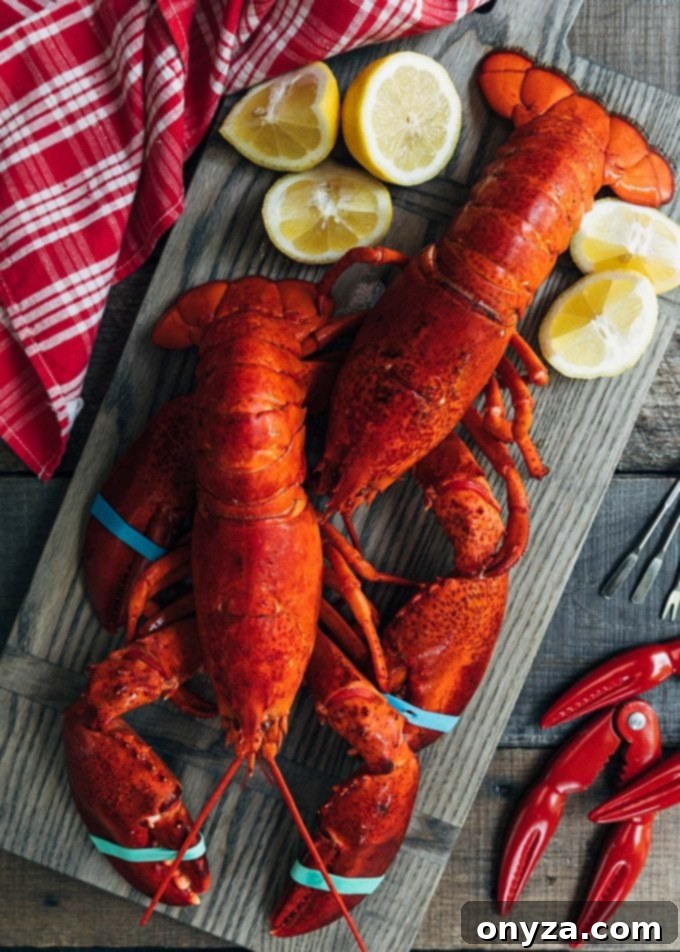
What Exactly is a Lobster Roll? A New England Culinary Icon
At its heart, a lobster roll is a quintessential New England sandwich, featuring generous mounds of sweet, succulent lobster meat nestled into buttered and griddled split-top hot dog buns. One bite instantly transports you to the seaside, evoking the soothing sound of ocean waves, the embrace of warm, salty breezes, and the feel of sand between your toes. It’s more than just a sandwich; it’s summer encapsulated in a bun, a celebrated dish that has captivated seafood lovers for generations.
The defining characteristic that differentiates various styles of New England Lobster Rolls lies in how the lobster meat is prepared and dressed. In the culinary world, recipes generally fall into two primary categories: Connecticut-style and Maine-style. Understanding these distinctions is key to appreciating the regional nuances of this beloved dish.
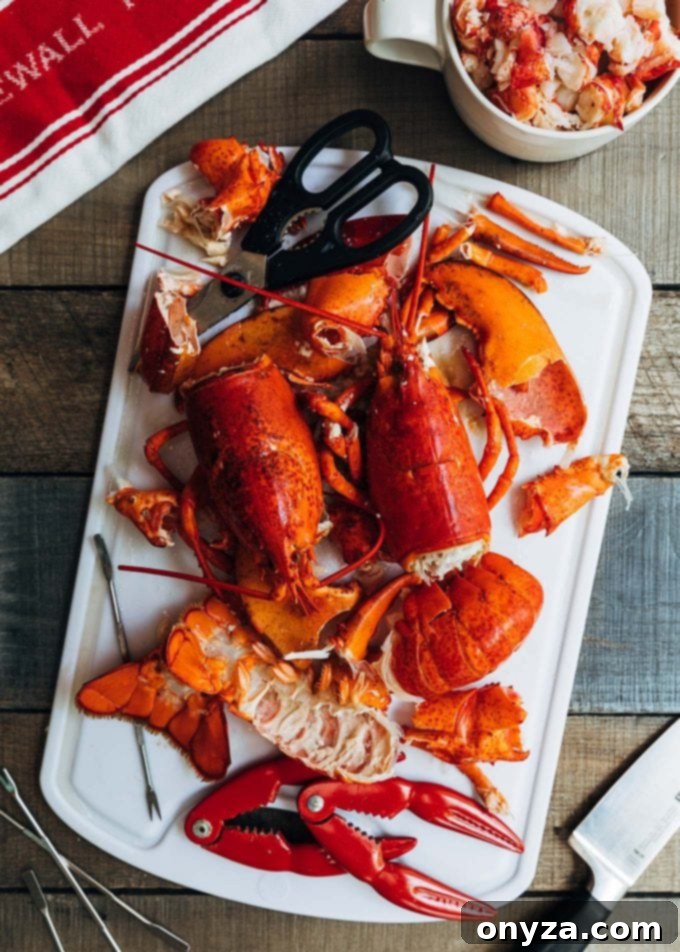
Maine vs. Connecticut Lobster Rolls: Decoding the Classic Styles
The debate between Maine and Connecticut-style lobster rolls is a passionate one among New Englanders and seafood aficionados alike. While both celebrate the glorious taste of fresh lobster, they approach its preparation with distinct philosophies, resulting in unique culinary experiences.
For Maine Lobster Rolls, the exquisite steamed lobster meat is gently cooled and then delicately dressed with a high-quality mayonnaise. This lobster salad is traditionally served chilled, generously piled into a buttery, griddled split-top hot dog bun. Occasionally, you might encounter a purist’s version where the lobster meat is unadorned, with a thin layer of mayonnaise spread directly onto the bun instead, allowing the lobster’s natural sweetness to shine even more brightly.
In contrast, Connecticut Lobster Rolls offer a warm, comforting experience. The lobster meat, fresh from steaming, is tossed with rich, melted drawn butter and then mounded into a similarly prepared hot dog bun. The key distinguishing factor here is the absence of mayonnaise, with butter taking center stage to complement the lobster’s flavor.
It’s worth noting that while these styles bear state names, you’ll find both variations served throughout New England. I’ve personally enjoyed mayo-based lobster rolls (sometimes called “lobster salad rolls”) in Connecticut and butter-dressed versions in Maine. However, as a general rule, if you hear “Maine-style,” anticipate a chilled, mayonnaise-dressed lobster roll; if it’s “Connecticut-style,” expect it warm and butter-laden. Each offers a delicious, authentic taste of New England’s vibrant culinary heritage.
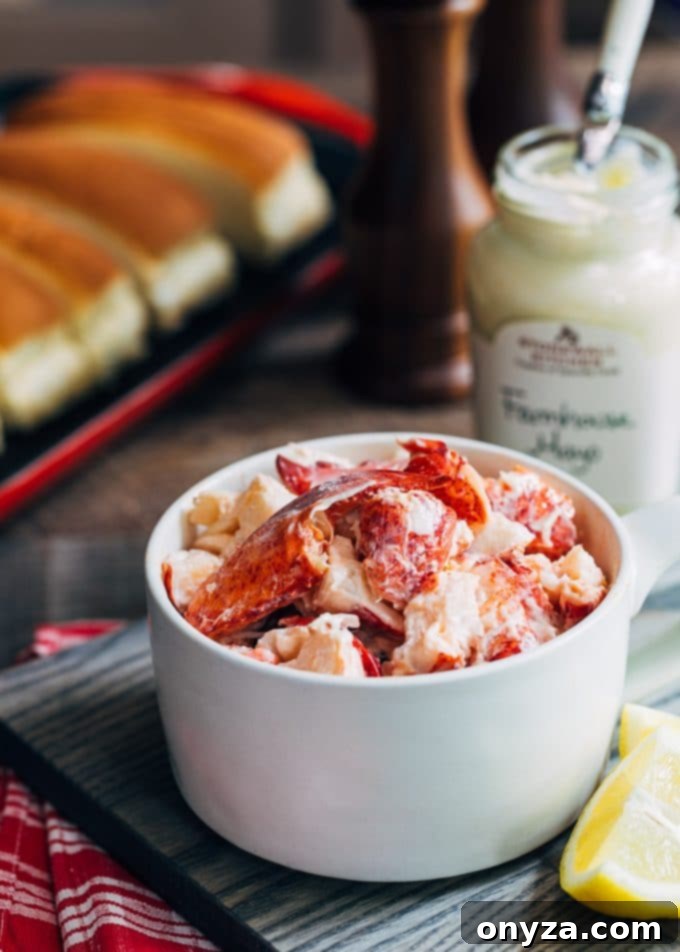
Crafting the Classic Maine Lobster Roll: A Step-by-Step Guide
At the heart of any New England lobster roll, whether Maine or Connecticut style, is the star ingredient: the lobster itself. These sandwiches are designed to be simple, allowing the sweet, delicate flavor of fresh lobster to truly shine without being overshadowed by excessive ingredients.
For an optimal Maine lobster roll experience, I recommend using fresh lobsters that weigh approximately 1-1/2 pounds each. Typically, three such lobsters will yield about 1 pound of cooked lobster meat, which is the perfect amount for preparing four generously filled lobster rolls. Selecting the right size ensures tender, flavorful meat that’s ideal for this classic dish.
Choosing and Cooking Your Live Lobsters for the Best Rolls
The foundation of an exceptional lobster roll is perfectly cooked lobster meat. When it comes to preparing live lobsters at home, I prefer two classic and reliable cooking techniques: boiling or steaming, each offering distinct advantages.
Boiling is an excellent choice when you’re preparing several lobsters at once, making it particularly convenient for entertaining a crowd. The boiling water ensures even cooking, and many find that boiled lobster meat is often easier to extract cleanly from the shells. This method is quick and efficient for larger batches.
Steaming, on the other hand, is widely celebrated for producing incredibly tender and flavorful lobster meat. Because the lobsters aren’t submerged in water, their natural essences are concentrated, resulting in a more intense and sweet flavor profile. Steaming also makes it more challenging to overcook the lobsters, helping to prevent dry or tough meat.
For a humane cooking process, it’s recommended to sedate or desensitize lobsters before cooking. You can achieve this by freezing them for 15 to 30 minutes, or by dispatching them swiftly with a sharp knife prior to steaming. For detailed instructions on humane preparation, resources like “How to Humanely Kill a Lobster for Cooking” from The Spruce Eats provide valuable guidance. Prioritizing humane methods ensures both ethical treatment and superior culinary results.
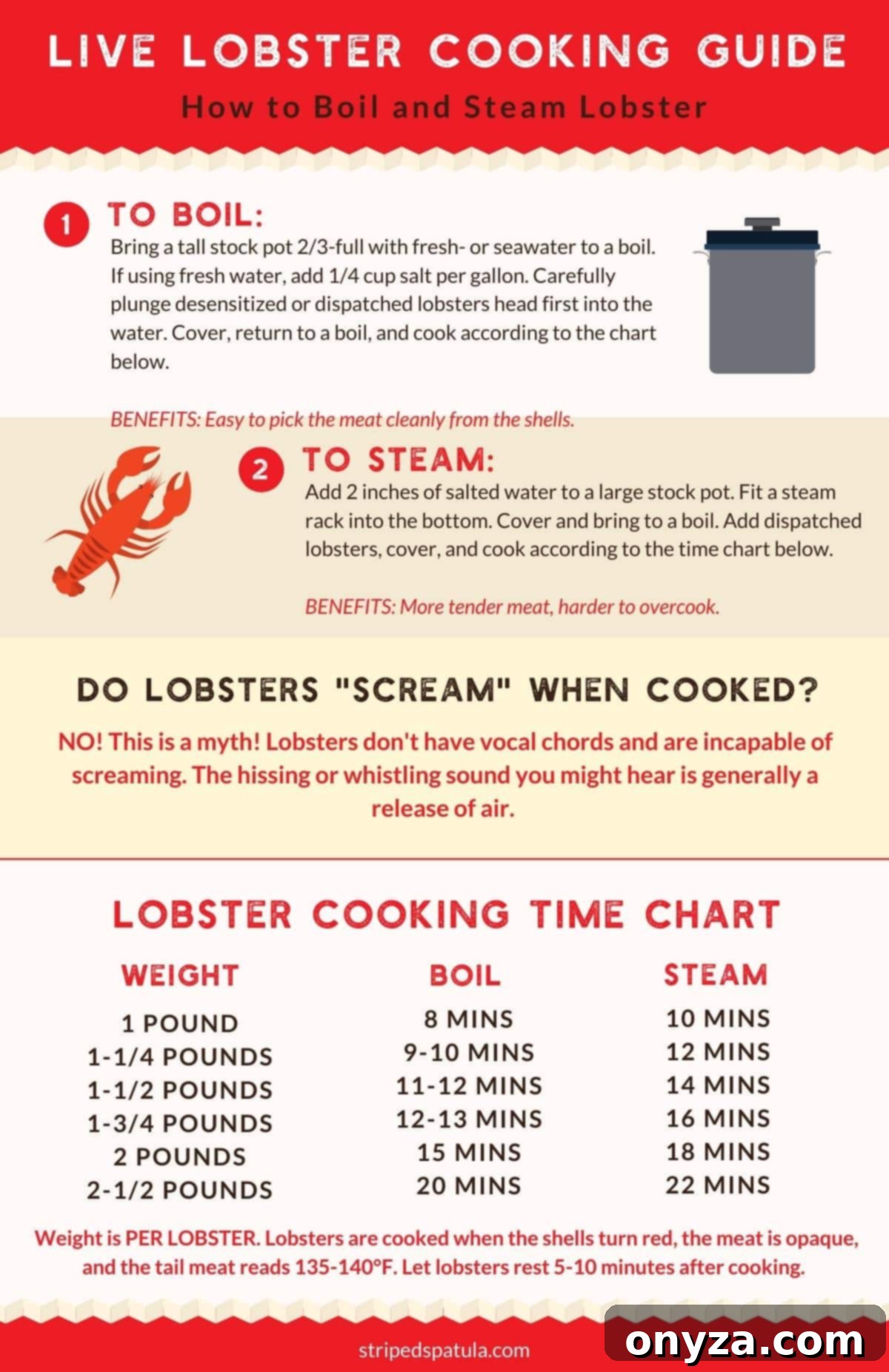
For more detailed information on various cooking techniques and expert tips for handling live lobsters, I highly recommend exploring guides from reputable seafood sources such as LobsterAnywhere.
From Cooked Lobster to Perfect Salad: The Art of Dressing
Once your lobsters are expertly cooked and cooled, the next step is to carefully remove the tail, knuckle, and claw meat from their shells. I recommend cutting the meat into large, substantial chunks to ensure each bite delivers a satisfying burst of lobster flavor and texture. Some traditional establishments leave the claw meat whole, elegantly placing it across the top of each roll for an impressive presentation. If you’ve managed to extract the claws in one piece, emulating this technique can elevate your homemade rolls significantly.
For an authentic Maine-style lobster roll, the key is a gentle touch when it comes to dressing. Toss the lobster meat with a good-quality mayonnaise—I personally prefer brands like Hellmann’s, Duke’s, Cains, or Stonewall Kitchen, or even a freshly made homemade version. The goal is to use just enough mayonnaise to lightly bind the lobster salad together, enhancing its creaminess without overpowering the natural sweetness of the lobster. It should be a subtle enhancement, not a drowning. Since the tartness of mayonnaise can vary by brand, I always taste the lobster salad after mixing and add a small squeeze of fresh lemon juice if a brighter, more vibrant flavor is desired.
Beyond the essential mayonnaise, additional ingredients in a Maine lobster roll are often a subject of lively debate among purists:
- Some classic recipes include finely chopped celery to add a subtle crunch and textural contrast. While a popular choice for many, I generally prefer my lobster rolls without it, allowing the lobster to remain the sole focus.
- The inclusion of lettuce in the bun before mounding the lobster salad is another debated topic. I enjoy a small leaf or two of delicate Bibb lettuce, which adds a fresh, crisp element without being obtrusive. However, I’m certainly not a fan of lobster rolls that skimp on lobster in favor of excessive lettuce.
- It’s important to note that while ingredients like capers, Dijon mustard, fresh tarragon, scallions, avocado, or bacon are undeniably delicious with lobster, they are not typically found in a truly classic Maine lobster roll. For the purist, sticking to the fundamentals is paramount.
In summary, for those who cherish the authentic Maine lobster roll experience, the recipe is elegantly simple: Fresh Lobster Meat, Quality Mayonnaise, and a Buttered, Griddled Hot Dog Bun. Optionally, a hint of celery and/or a touch of lettuce. That’s the unadulterated essence!

The Essential Element: New England Hot Dog Buns
The bun is not merely a vehicle for the lobster; it’s an integral component of the classic Maine Lobster Roll experience. The traditional choice is a split-top hot dog bun, but for true authenticity, seek out the specific New England-style buns that also feature flat, crustless sides designed explicitly for toasting. These unique buns are crucial for achieving the perfect texture and flavor.
The flat sides of New England hot dog buns are ideally suited for grilling. When buttered and toasted on a griddle, they develop a wonderfully golden, crispy exterior while maintaining a soft, yielding interior. This contrast in texture — a buttery crispness giving way to tender bread — perfectly complements the delicate lobster salad.
While split-top hot dog buns are becoming more widely available, finding the specific flat-sided New England variety outside of the region can still be a challenge. I often bring a package home with me after visiting New England, but they can also be found through specialty online retailers. For those who enjoy baking, you can even recreate these distinctive buns at home with a specific New England Hot Dog Bun pan, adding an extra layer of homemade charm to your rolls.
For an engaging read on the cultural significance and unique characteristics of these beloved buns, check out “In Praise of the New England Hot Dog Bun” from New England Today.
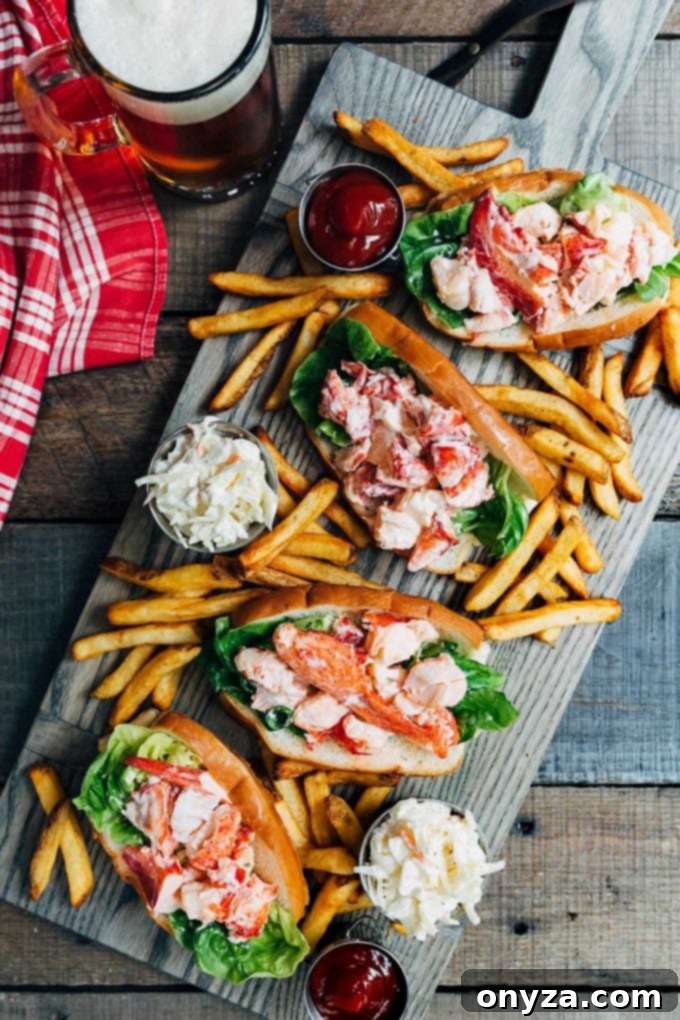
Pairing Perfection: What to Serve with New England Lobster Rolls
Just as if I were enjoying them oceanside, I love to serve these delightful Maine Lobster Rolls with classic accompaniments. Lightly seasoned French fries or crispy kettle chips are my go-to, providing that satisfying salty crunch. A fresh, homemade coleslaw also makes an excellent side, offering a cool, tangy contrast to the rich lobster. While I’ve seen them served with a dill pickle, my first instinct is always to reach for the fries or chips with a lobster roll!
For beverages, lobster rolls pair wonderfully with iced tea or a chilled beer. My favorite beer pairings include crisp, refreshing witbiers and witbier-style brews, such as the acclaimed Allagash White (proudly from Maine) or the classic Hoegaarden White. I also find that a good saison complements the delicate flavors of lobster beautifully. The key is to choose something light and crisp that won’t overpower the star of the show – the exquisite lobster itself. Remember, for an authentic and enjoyable lobster roll experience, the lobster’s flavor reigns supreme!

Maine Lobster Rolls
Ingredients
- 1 pound cooked lobster meat (shelled, drained, and cooled)*
- 3-4 tablespoons mayonnaise (I use Hellmann’s, Duke’s, Cains, Stonewall Kitchen, or homemade)
- ¼ cup finely chopped celery (optional, for those who like a little “crunch”)
- Freshly-squeezed lemon juice (optional)
- Kosher or sea salt and freshly-ground black pepper to taste
- 4 large lettuce leaves (optional, I use Bibb)
- 4 split-top, flat-sided hotdog buns (“New England” style)
- 2 tablespoons unsalted butter, softened
Instructions
- Remove and discard any stray bits of shell or cartilage from the lobster meat and cut it into large chunks (about 3/4-inch). Sometimes, you’ll see the claw meat left whole, placed across the top of the roll for an impressive presentation.
- In a bowl, gently toss lobster with 3 tablespoons mayonnaise and celery (if using). The lobster should be lightly-coated, but not weighed down by the mayonnaise. Add an additional tablespoon of mayonnaise, if needed.
- Taste the lobster salad. Some brands of mayo are a bit tangier than others. If the salad needs more brightness, add a squeeze of fresh lemon juice. Season to taste with salt and pepper.
- Cover the lobster salad and refrigerate for 30 minutes, or up to 6-8 hours if prepping ahead.
- To assemble the lobster rolls, preheat a griddle over medium heat. Butter the flat sides of the hotdog buns and grill for just a couple of minutes per side, until toasted and golden brown.
- Place lettuce (if using) onto each bun and mound generously with 1/4 of the lobster salad. Serve immediately with your favorite sides, such as coleslaw, dill pickles, french fries, or kettle chips.
Notes
In general, plan to cook three, 1-1/2 pound lobsters for the 1 pound of meat needed for this recipe. Lobster meat yield can vary by season, so consult with your seafood market when purchasing.
To Cook Live Lobsters
For step-by-step instructions, see the Lobster Cooking Guide infographic in the blog post above for details on boiling and steaming.
To save time, you can also ask your seafood market or the seafood counter at your grocery store to steam the lobsters for you. Some will even remove the meat from the shells, making your prep even easier.
Nutrition Estimate
Calories: 328 kcal |
Carbohydrates: 21 g |
Protein: 23 g |
Fat: 15 g |
Saturated Fat: 5 g |
Cholesterol: 163 mg |
Sodium: 764 mg |
Potassium: 297 mg |
Sugar: 3 g |
Vitamin A: 205 IU |
Vitamin C: 0.6 mg |
Calcium: 171 mg |
Iron: 1.7 mg
Nutrition information is automatically calculated, so should only be used as an approximation.
Please note that our recipes have been developed using the US Customary measurement system and have not been tested for high altitude/elevation cooking and baking.
Like this? Rate and comment below!
